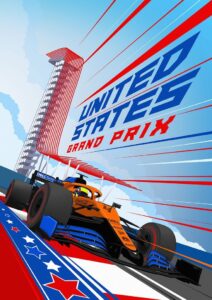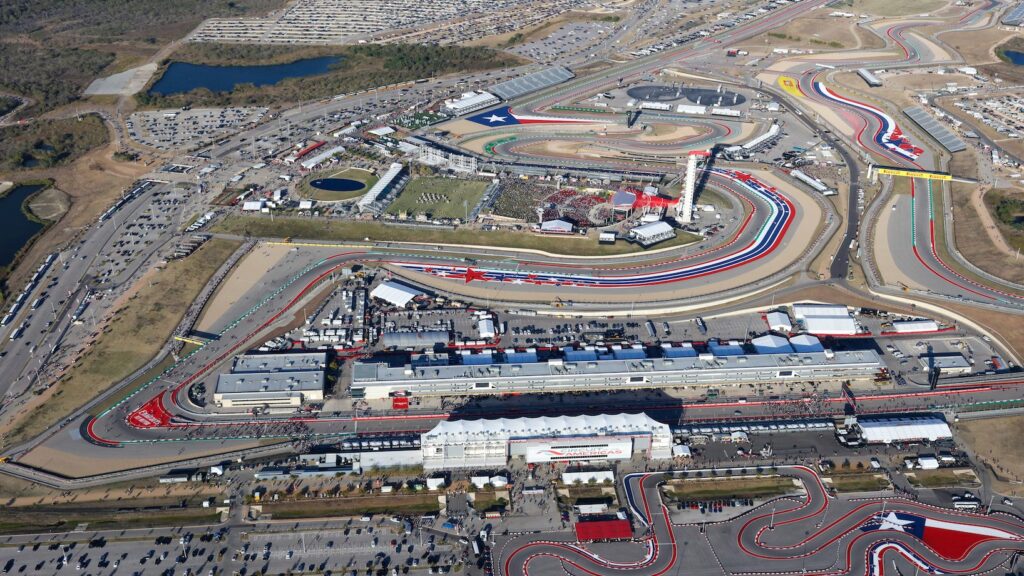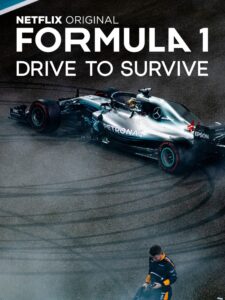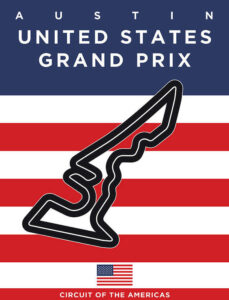The Religious Revival of American Formula One Racing
The car racing league's growing popularity and its connections with Christian nationalist and antidemocratic politics

(Image design by Jason Pooley)
I wasn’t in the real-life throng of 140,000 spectators in Austin, Texas, but through my TV screen, I attended an uncanny, high-octane revival on October 24, 2021.
On that date and over two days preceding it, Austin played host to the United States Formula One Grand Prix, the only U.S.-based pit stop for the world’s preeminent car racing league. Relatively unknown in the U.S. until recently, Formula One (F1) features superlatively skilled drivers maneuvering the world’s fastest race cars in locations spanning the globe. F1 is like Top Gun on wheels: The cars operate at speeds rivaling those of a fighter jet at takeoff, and the franchise has worldwide recognition with global viewership numbers hovering around 450 million per year. Racing teams draw seas of supporters at their home races. In other countries, individual racers like Michael Schumacher and Lewis Hamilton are veritable household names, their portraits and team flags placed beside a home’s religious idols and family portraits.
F1 is a big-budget world tour of one-off (and very fancy) tent revivals: Locals and globetrotters come together in the name of championship glory and team loyalty, and, after the trademark champagne-soaked trophy lifting that marks the end of every grand prix weekend, the teams’ armada of logistics coordinators pack everything up and repeat the ritual somewhere else. They do this more than 20 times per year. Legions of F1 fans make multi-sited pilgrimages to the winding streets of Monaco, the luxurious but muggy harbor of Singapore, and the alpine splendor of Austria.
Unlike the F1 races that weave through public streets in locations like Monaco, the U.S. Grand Prix brings an otherwise austere concrete husk to life. Over the marquee event weekend in 2021, the Circuit of the Americas (COTA), a sprawling 1,500-acre compound with a meandering 3.41-mile racetrack at its center, hummed with record-breaking crowds. (The complex also features an amusement park.) More than 400,000 attendees gathered across three days of practice runs, qualifying sessions, and, finally, the race on Sunday.

(Image source: R. Kevin Butts photo – Courtesy of COTA)
Appropriate for a Sunday morning, the race’s TV coverage began with a sermon-esque video narrated by Willy T. Ribbs, the first Black man to drive an F1 race car. Ribbs’s introduction was like a charismatic and cowboy hat-festooned version of theologian Paul Tillich’s post-WWI sermon “The Shaking of the Foundations,” in which Tillich says that faith will swing humanity one way or another at its most decisive juncture: between inevitable destruction or eternal salvation. In an equally dramatic monologue, Ribbs detailed the unprecedented nature of the moment before us. Together in Austin on that day, we could witness the shattering of an F1 dynasty and the rise of a new order—or the solidification of the incumbent faction’s power. Seven-time world champion Lewis Hamilton was six points behind up-and-coming challenger Max Verstappen in the drivers’ championship. With only six races remaining in the season, a decisive win for Verstappen or Hamilton could cement a championship lead for either driver.
“Where better for the next showdown?” Ribbs asked, perched atop COTA’s 230-foot observation tower as the camera panned to the rest of the sun-kissed megaplex. “‘Cause everything’s bigger in Texas—right?”
The cliché wasn’t just a marketing ploy. There is arguably no place better for a massive automotive showdown than Austin, because the city and state made it so. Unlike Monaco or Singapore, Austin has used media and statecraft over decades to bill and build itself as a go-to destination for congregational economies, movements looking for physical space to come together temporarily.
One starting point for Texas’s congregational economics is in the 1980s; flagship music and tech festival South by Southwest (SXSW) has famously drawn hordes of conference-goers to Austin every March since then. Barring a downturn since the onset of the Covid-19 pandemic, the festival has grown steadily—417,000 people attended in 2019—and, crucially, has encouraged a growing infrastructural footprint to sustain sudden surges of out-of-towners, including an 881,400-square-foot conference center and nearly 50,000 hotel beds.
Despite many trenchant political differences between them, local and state officials have often worked in lockstep to build this niche economic landscape. In the initial ten-year contract between the Formula One Group (F1’s parent company) and state and county leaders, the Texas State Legislature offered $250 million in public money, including $35 million in 2021 alone, in exchange for the right to host the only F1 race in the United States. With support from billionaire Red McCombs, investor Bobby Epstein constructed the COTA race course specifically for F1. His private investment firm, the holy-sounding Prophet Capital Management Ltd., owned the land on which COTA was built. Key stakeholders have touted the estimated tax and jobs windfalls of massive events like SXSW and F1’s Grand Prix over the years, implying that this economy fueled by state monies should not just continue, but grow in scale and frequency.
Other fandoms and movements have since flocked to Austin: a burgeoning tech scene, a Tesla Gigafactory, and a new Major League Soccer Stadium. These groups have left an indelible mark on the city and state, creating a mix of part-time jobs for stadium work as well as high-paying tech salaries, with very little in between. But the influence flows both ways. Austin and Texas have shaped these congregations in their own image, too.
***
The 2021 F1 race in Austin was unlike any other preceding it, and not only because of its “everything’s bigger in Texas”-sized crowds. It featured new, stereotypically American attractions that would not fly in F1’s more cosmopolitan venues across the pond: gimmicks like a Spam-eating contest and a DJ set by Shaquille O’Neal. Daniel Ricciardo, the affable Australian driver for the McLaren racing team, rocked a cowboy hat and spun donuts on the COTA racetrack in a vintage NASCAR muscle car. Detractors and boosters alike judged the weekend as the inaugural production of “Formula One: American Style.”
The Formula One Group has made use of cutting-edge technologies to tell its story since its founding in 1950. An expert in global supply-chain solutions, it masters air, land, and sea to transport multimillion-dollar vehicles, tools, paddock buildings, and other supporting infrastructure to make the physical plant of every race both standardized and locally distinct. The Group also sits at the forefront of live sports broadcasting; rather than mixing and broadcasting a single feed from the racetrack, it directs, produces, and transmits grand prix broadcasts from its headquarters south of London, receiving a whopping bandwidth of ultra-high-definition feeds from more than 100 on-track cameras and cutting them into a dramatic, curated feed on-site—tracking overtakes, following popular drivers’ on-board feeds and radio communications with their pit crew, and showing every angle of a crash. Dubbed the “World Feed,” these visuals cannot be altered by local TV networks so that F1 viewership is a uniform experience globally; local commentators dub the video in real time across more than 100 countries. All of this with only a seven-second delay between camera and TV screen. Eyeing F1’s narrative and technological promise, U.S.-based Liberty Media Corporation acquired the Formula One Group in 2017 for $4.4 billion. Liberty has redoubled F1’s investment in spectacle production and culture cultivation, tapping into American technologies and moneyed audiences in the process.
“We really invested and bought Formula One on the basis that there was enormous opportunity in the United States,” President and CEO of Liberty Media, Greg Maffei, said during an interview with Bloomberg in May. “The Austin race has gone from being something that had a hard time selling 80,000 tickets a few years back to doing over 400,000 this past October.” Surging U.S. interest also means that, after a three-year contract at $5 million per year, ESPN has recently renewed its F1 broadcasting rights with Liberty at a much higher rate, between $75 million and $90 million per annum.
Key to this surge in tickets and broadcasting rights is another U.S. invention: Netflix.
Drive to Survive, a TV series co-produced by the Formula One Group and Netflix, reveals the intrigue, danger, oligarchic grift, and manchild pettiness fueling this multibillion-dollar sports subculture. Launched in December 2019, the series has recently been renewed for a fifth season and has spurred interest in the sport among a younger demographic. The astounding privileges and constant danger that define the series—everything from drivers without billionaire parents struggling to secure a spot in the league to a petulant Swiss-French driver surviving a fireball explosion after crashing at the Bahrain Grand Prix—paired with actual F1 race highlights, have birthed a burgeoning meme culture and fandom around the sport.
 Maffei said F1’s tie-up with Netflix is both an effort to Americanize the sport’s viewership as well to bring more age and gender diversity to the sport’s support base. Drive to Survive accomplishes this by converting online viewers into real-life attendees. The series has successfully yoked a youthful, flourishing F1 cyberculture to physical space. At the 2021 race in Austin, which was the first F1 grand prix to take place in the U.S. since Drive to Survive premiered, attendance was up 30% from five years earlier. Seventy percent of ticket-holders were first-timers.
Maffei said F1’s tie-up with Netflix is both an effort to Americanize the sport’s viewership as well to bring more age and gender diversity to the sport’s support base. Drive to Survive accomplishes this by converting online viewers into real-life attendees. The series has successfully yoked a youthful, flourishing F1 cyberculture to physical space. At the 2021 race in Austin, which was the first F1 grand prix to take place in the U.S. since Drive to Survive premiered, attendance was up 30% from five years earlier. Seventy percent of ticket-holders were first-timers.
“I think this is definitely our acceptance into the U.S.,” said Lewis Hamilton after the race, in which he placed second to Verstappen. (He would later lose the drivers’ championship to Verstappen in a highly controversial final race.)
The head of Red Bull’s racing team, Christian Horner, echoed Hamilton’s post-race sentiments. “Fantastic to see the American fans and public engaging in Formula One,” he said. “We can thank Netflix, but without great content then it’s not a good show, and I think the racing today really delivered and I think the fans are really engaging with what F1 can deliver.”
Other drivers reported being recognized in public more frequently than in prior years; and they were wowed by the race’s size and American flair. “The anthem at the beginning, that was cool and just seeing up the hill the sea of people in the crowd…” donut-spinning Daniel Ricciardo commented without finishing his thought. “[The race is] one of the cooler ones so I hope we keep coming back again and again.”
***
Watching F1 helped me see why so many people compare sports enthusiasm to religion, or call sports a religion tout court, despite critical, manifold differences between the two. Some argue in favor by highlighting lexical similarities: “faith, devotion, worship, ritual, dedication, sacrifice, commitment, spirit, prayer, suffering, festival, and celebration,” notes psychologist Dr. Daniel L. Wann. A different approach is more liturgical and takes major events like the Super Bowl to conclude that sports are something of a “civil religion” in the United States, forming one of the many unspoken religious practices defining the nation and its adherents. Others frame stadiums as a “sacred space,” mass gatherings and “powerful social experiences” a conduit for what sociologist Émile Durkheim calls “collective effervescence,” pre-game rituals a superstition, and so forth.
One could also take the view of scholars such as political theorist Dr. William E. Connolly to conclude that race weekends like the U.S. Grand Prix—laden with nation-worship rituals, celebrations of wealth, testimony to both individual agency (drivers’ decisions) and communal transcendence (being one of many spectators)—form part of what Connolly dubs in Capitalism and Christianity, American Style as “a spiral of resonances between evangelism and cowboy capitalism.” Complementing a network of “media, churches, electoral campaigns, and financial reporting to infiltrate the cultural unconscious,” this spiral imbues the religious right’s spiritualism into institutional practices by grafting those values onto what gets called “common sense.”
 But it’s not just uncanny echoes driving congregational economies like the Grand Prix. Traceable institutional practices and finances can further shed light on their religiosity; Texas state politics help explain how Formula One is conferred many of the same tax and political privileges as organized Christian groups in the state—rights not bestowed upon small businesses or new religious movements.
But it’s not just uncanny echoes driving congregational economies like the Grand Prix. Traceable institutional practices and finances can further shed light on their religiosity; Texas state politics help explain how Formula One is conferred many of the same tax and political privileges as organized Christian groups in the state—rights not bestowed upon small businesses or new religious movements.
The religious practices buttressing Austin’s congregational commerce are of a specific theopolitical strain. Texas sits at the forefront of contemporary white Christian nationalism for more reasons than just its size and electoral votes. Its history of frontierism, enslavement, organized white conservative Protestantism, and fiscal conservatism are decisive variables that make Lone Star State politics notably white Christian nationalist, according to Dr. Robert Wuthnow in Rough Country: How Texas Became America’s Most Powerful Bible-Belt State.
In the context of the Grand Prix, F1’s races create a mediated, imagined community centered around fast cars, and monetizes this demographic through a seemingly endless stream of ancillary services, ranging from exclusive streaming subscriptions to race day tickets typically costing hundreds of dollars. The league also transmutes its congregation of viewers into theopolitical power for investors and politicians. As Wuthnow contextualizes:
“The most neglected aspect of American religion occurs in the middle range at the level that bridges families and congregations with the nation… Families and congregations effectively combine and channel their interests through entities that are large enough to convey power and yet not so large as to be impersonally beyond reach. This is American federalism… Something similar characterizes American religion as well.”
In exchange for $250 million and tax-free status, the Texas state government has had the opportunity to broadcast its version of what exemplary Americanism should look like to F1’s hundreds of millions of viewers worldwide. With the world’s most advanced cars whizzing around a track, and with a high-profile list of attendees like Rory McIlroy, Megan Thee Stallion, Ben Stiller, and Serena Williams, lawmakers use the aesthetics and glamor of the Grand Prix to suggest that Texas’s theopolitical agenda isn’t just benign, but so futuristic that it attracts both tech and superstar prowess. And F1 continues to operate in a state governed by white Christian nationalists who are at the forefront of anti-abortion political schemes as well as lethal and racist anti-immigration enforcement.
Like many movements preceding it, F1 has used Texas as a spawning ground and is now spreading to other parts of the United States. The Miami Grand Prix joined the race calendar this year, making it the second U.S.-based race, and the second to be based in a state at the forefront of conservative Christian state politics. The Formula One Group also recently announced that it is adding Las Vegas as a third destination, meaning the U.S. will have more F1 races than any other country. The Austin race, while no longer the exclusive F1 event in the country, is retaining the right to be called the United States Grand Prix, which lets Texas broadcast its synecdochal relationship to Americanism.
U.S. and European media outlets have occasionally raised the thorny topic of F1’s place in politics, but have largely done so through an Orientalist lens. When asked by Bloomberg why Formula One continues to hold a Grand Prix in Saudi Arabia, which has been responsible for war crimes in Yemen, Liberty Media CEO Maffei said F1 “wouldn’t race anywhere” if they responded to every political complaint. “Maybe Norway,” he said sarcastically.
The reporter, tellingly, did not ask Maffei to justify F1’s races in the United States, despite an extensive history of human rights violations by U.S. state forces and settlers both domestically and abroad. Doing so could have raised uncomfortable questions about the political beliefs of the U.S. Grand Prix’s main benefactors as well as the consequences of their political efforts. COTA’s primary investor, Red McCombs, a billionaire who amassed his fortune by building a car sales empire, avidly supported Donald Trump’s presidential campaign, citing fiscal conservatism as the basis for his endorsement. “Not everything [Trump] says everyone agrees with. You don’t have to,” McCombs said in an interview. “But the big thing is we know he wants more sensible and stable taxing rates.” McCombs had previously supported Texas Senator Ted Cruz for President; McCombs said he “was on hands and knees for our great senator who would’ve been a great president.”
Reading between the lines of Maffei’s sassy retort, maybe F1 can only race in places with thorny, antidemocratic politics and histories, and, at least obliquely, enact the thepolitical beliefs of its white benefactors and traditionally white support base. Former kingpin of the Formula One Group, Bernie Ecclestone, certainly thinks so, telling news program “Good Morning Britain” in late June that Russian President Vladimir Putin is “a first-class person” for whom he would “take a bullet.” Under Liberty’s ownership, the league did respond symbolically to Russia’s invasion of Ukraine, removing the Russian Grand Prix from its race calendar and effectively kicking out the league’s sole Russian driver due to his (billionaire) father’s connections to the Kremlin. (Sanctions made things complicated, too.) The U.S. Grand Prix does not need to kick the hornet’s nest or make overt political or theological statements in favor of conservative agendas to have thepolitical effects, however: The money flows toward McCombs and his theopolitical slant whenever fans congregate at COTA and surrender to the enrapturing show.
***
I traveled to Austin in March to attend this year’s SXSW, the city’s most well-known congregational-economy event. Taking place before the crypto sector’s complete nosedive, the conference was overrun with crypto bros touting the future of NFTs and decentralized finance. At one panel I attended between networking events, one speaker channeled pseudo-manifest destiny thinking to describe the metaverse as “magic dust” that can rid the world of racism through virtual reality headsets.
I rented a car and drove out to COTA to nurse my spiking cortisol and F1 FOMO. Save for a sparse smattering of trees, the complex was devoid of life. Rows of port-a-potties, vacant parking lots, even a comatose roller coaster, suggested Texas pols were far from the “rational actors” driving the free-market capitalism they espouse. COTA is a waste: a destroyed grasslands designed for rare human use.
Much like Austin’s open relationship with different fandoms—from cryptoevangelists to car enthusiasts—little suggests F1 will stay faithful to the Lone Star State in the long run. If “Formula One: American Style” becomes less profitable, Liberty will pack up its caravan and find a new host for its moneyed revival. Austin’s marketed promise as a pilgrimage site of online fandoms is little more than a speedy race to the bottom, leaving Texas with an insatiable coterie of oligarchs gunning for another needless roadway.
Adam Willems (@functionaladam) reports on finance, technology, and religion from Seattle. They also write Divine Innovation, a newsletter on religion and technology.